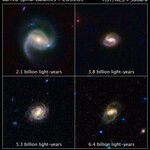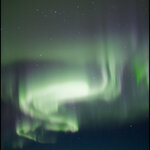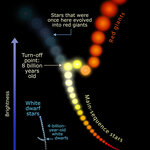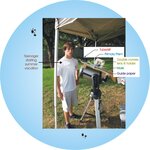Space

On August 1, a total solar eclipse was visible in parts of Canada, northern Greenland, the Arctic, central Russia, Mongolia and China. The eclipse swept across Earth in a narrow path that began in Canada’s northern territory of Nunavut and ended in northern China’s Silk Road region.
Though the eclipse was not visible in most of North America, NASA TV and the Exploratorium made streaming video of the event available online. The following images are taken from that video, shot from the Xinjiang Uygur Autonomous Region in northwestern China near the Mongolian border. The sun appears differently…

Titan, which is one-and-a-half times the size of Earth's moon and bigger than either Mercury or Pluto, is one of the most fascinating bodies in the solar system when it comes to exploring environments that may give rise to life.
Scientists have confirmed that it has just gotten more interesting - it has a surface liquid lake in the south polar region. Titan is truly wet. The lake is about 235 kilometers, or 150 miles, long, according to the visual and infrared mapping spectrometer, or VIMS, on NASA's Cassini orbiter, which identifies the chemical composition of objects by the way matter…

A frequent sign of the maturity of a spiral galaxy is the formation of a ribbon of stars and gas that slices across the nucleus, like the slash across a "no smoking" sign.
In a landmark study of more than 2,000 spiral galaxies from the largest galaxy census conducted by NASA's Hubble Space Telescope, astronomers found that so-called barred spiral galaxies were far less plentiful 7 billion years ago than they are today, in the local universe.
The study's results confirm the idea that bars are a sign of galaxies reaching full maturity as the "formative years" end. The observations are part of…

A team of European scientists working with COROT have discovered an exoplanet orbiting a star slightly more massive than the Sun. After just 555 days in orbit, the mission has now observed more than 50 000 stars and is adding significantly to our knowledge of the fundamental workings of stars.
The latest discovery, COROT-exo-4b is an exoplanet of about the same size as Jupiter. It takes 9.2 days to orbit its star, the longest period for any transiting exoplanet ever found.
The team has found that the star, which is slightly larger than our Sun, is rotating at the same pace as the planet's…

Themis was the blindfolded Greek goddess of order and justice. It's also a NASA-funded mission which stands for Time History of Events and Macroscale Interactions during Substorms - and, using it, UCLA space scientists and colleagues have identified the mechanism that triggers substorms in space; wreaks havoc on satellites, power grids and communications systems; and leads to the explosive release of energy that causes the spectacular brightening of the aurora borealis, also known as the northern lights.
For 30 years, there have been two competing theories to explain the onset of these…

Using ESO's Very Large Telescope Interferometer, astronomers were able to witness for the first time the appearance of a shell of dusty gas around a star that had just erupted and follow its evolution for more than 100 days. This provided the astronomers with a new way to estimate the distance of this object and obtain invaluable information on the operating mode of stellar vampires, dense stars that suck material from a companion.
Although novae were first thought to be new stars appearing in the sky, hence their Latin name, they are now understood as signaling the brightening of a small,…

By using the gravitational magnification from six massive lensing galaxy clusters, the NASA/ESA Hubble Space Telescope has provided scientists with the largest sample of very distant galaxies seen to date. Some of the newly found magnified objects are dimmer than the faintest ones seen in the legendary Hubble Ultra Deep Field, which is usually considered the deepest image of the Universe.
By combining both visible and near-infrared observations from Hubble's Advanced Camera for Surveys (ACS) and Near Infrared Camera and Multi-Object Spectrometer (NICMOS), scientists searched for galaxies that…

For the first time, a team of international researchers has found a way to view the accretion disks surrounding black holes and verify that their true electromagnetic spectra match what astronomers have long predicted they would be.
A black hole and its bright accretion disk have been thought to form a quasar, the powerful light source at the center of some distant galaxies. Using a polarizing filter, the research team, which included Robert Antonucci and Omer Blaes, professors of physics at the University of California, Santa Barbara, isolated the light emitted by the accretion disk from…

Imagine having three clocks in your house, each chiming at a different time.
Astronomers have found the equivalent of three out-of-sync "clocks" in the ancient open star cluster NGC 6791. The dilemma may fundamentally challenge the way astronomers estimate cluster ages, researchers said.
Using NASA's Hubble Space Telescope to study the dimmest stars in the cluster, astronomers uncovered three different age groups. Two of the populations are burned-out stars called white dwarfs. One group of these low-wattage stellar remnants appears to be 6 billion years old, another appears to be 4 billion…

Continuing from the prior article...
“The Sun Ain’t Yeller”, cries the heliochromologist. Undaunted by tradition, dogma, or tens of thousands of erroneous magazine and textbook images of our Sun, heliochromology, a colorful heterodox, is winning the day because the Sun is what it is, color and all, regardless of other’s puerile incognizance.
The answer is not a vague, subjective one, but an objective one, as sure as red apples are red. Heliochromology is our path to enlightenment that will bring resolve to this color conundrum -- a subtle polemic that has been dormant to…